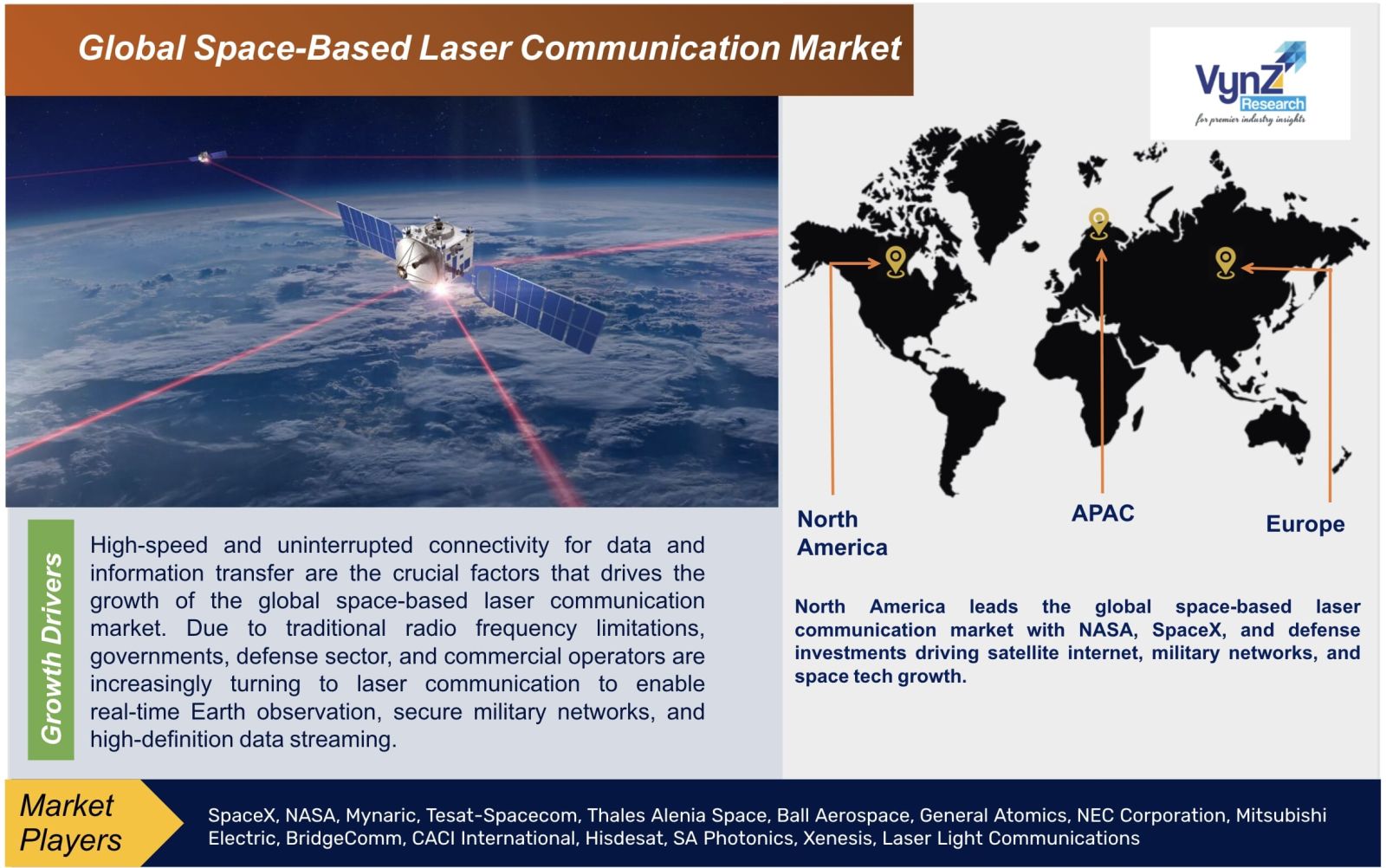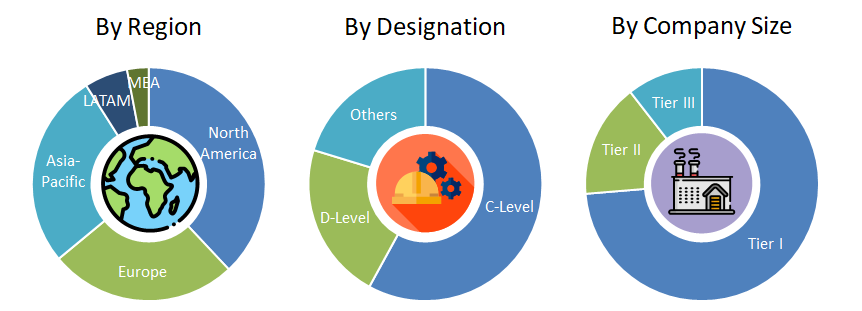Global Space-Based Laser Communication Market Size & Share | Growth Forecast Report 2035
Industry Insights By Type (Inter-Satellite Links, Satellite-to-Ground Links and Deep Space Communication), By Solution (Equipment, Services and Software), By Application (Communication & Backhaul, Earth Observation, Remote Sensing and R&D), By End User (Government & Defense, Commercial and Space Agencies) and By Geography (North America, Europe, Asia Pacific, Rest of the World)
| Status : Published | Published On : Sep, 2025 | Report Code : VRICT5196 | Industry : ICT & Media | Available Format :

|
Page : 140 |
Global Space-Based Laser Communication Market Size & Share | Growth Forecast Report 2035
Industry Insights By Type (Inter-Satellite Links, Satellite-to-Ground Links and Deep Space Communication), By Solution (Equipment, Services and Software), By Application (Communication & Backhaul, Earth Observation, Remote Sensing and R&D), By End User (Government & Defense, Commercial and Space Agencies) and By Geography (North America, Europe, Asia Pacific, Rest of the World)
Industry Overview
The Global Space-Based Laser Communication Market size was valued at USD 0.6 billion in 2025. It is likely to grow up to USD 3.9 billion by 2035 at a CAGR of 21% during the forecast period ranging between 2026 and 2035.

The most crucial factor riding the increase of this marketplace is its growing use within the defense and safety quarter, specially within the US and Europe. Here, seamless and fast communication is extraordinarily crucial due to rising geopolitical tensions and the want for robust space resources. Spacecrafts and satellites use space-based laser communication technology to send data and records. This sector makes use of fast and slender laser beams rather than conventional radio waves, thereby achieving greater velocity and better bandwidth. It is just as fiber optic, but right here all the facts aredispatched through space or vacuum. The gains of this technology include ultra-speed internet, low latency, and ease in data and information switch as laser beams are very narrow. It is being used in deep space missions, satellite-to-satellite links, Earth observation, and global broadband services. In the future, it will revolutionize space internet and interplanetary communication.
Global Space-Based Laser Communication Market Report Coverage
|
Report Metric |
Details |
|
Historical Period |
2020 - 2024 |
|
Base Year Considered |
2025 |
|
Forecast Period |
2026 - 2035 |
|
Market Size in 2025 |
U.S.D. 0.6 Billion |
|
Revenue Forecast in 2035 |
U.S.D. 3.9 Billion |
|
Growth Rate |
21% |
|
Segments Covered in the Report |
By Type, By Solution, By Application and By End User |
|
Report Scope |
Market Trends, Drivers, and Restraints; Revenue Estimation and Forecast; Segmentation Analysis; Impact of COVID-19; Companies’ Strategic Developments; Market Share Analysis of Key Players; Company Profiling |
|
Regions Covered in the Report |
North America, Europe, Asia Pacific, Rest of the World |
Global Space-Based Laser Communication Industry Dynamics
Global Space-Based Laser Communication Market Trends/Growth Drivers:
Increasing Demand for Fast and Seamless Connectivity
High-speed and uninterrupted connectivity for data and information transfer are the crucial factors that drives the growth of theglobal space-based laser communication market. Due to traditional radio frequency limitations, governments, defense sector, and commercial operators are increasingly turning to laser communication to enable real-time Earth observation, secure military networks, and high-definition data streaming. This trend is growing rapidly especially in North America and Europe, where satellite broadband, cloud computing, and space exploration projects are flourishing.
Apart from that, a few other factors that pushes market growth include rising demand in remote areas in Asia-Pacific region, technological developments like compact laser terminals, cost-efficiency, productive public-private alliance, and investments in inter-satellite links and space from private space companies for 5G connectivity.
Global Space-Based Laser Communication Market Challenges
High Deployment Costs and Technical Complexity
The biggest challenge of the global space-based laser communication market is the high cost of this technology. Laser terminals require advanced materials, precision engineering, and complex system integration to last in the harsh environment of space, which increases costs. Also, perfect alignment between moving satellites is technically complex and requires adaptive tracking systems. In addition, atmospheric interference, regional regulations, cybersecurity, and a shortage of skilled professionals are also major obstacles.
Global Space-Based Laser Communication Market Opportunities
Expansion of Global Satellite Internet and Mega Constellations
The most notable growth opportunity of the global space-based laser communication market is the significant rise in the number of mega constellations and satellite internet services such as Starlink, OneWeb, and more. They require super-fast and secure internet links with satellites to ensure seamless communication. Also, developing markets in Asia-Pacific, Africa, and Latin America create new opportunity to eradicate digital divide. The defense and government sectors also want encrypted, jam-resistant systems. Small satellite operators, scientific missions, and miniature laser terminals and low-cost launches for future interplanetary communications are also creating opportunities.
Recent Developments by the Key Players:
Thales Alenia Space has partnered with Telespazio to design and develop the space segment of the Navigation System and satellite navigation infrastructure for ESA’s Moonlight Lunar Communications and Navigation Services (LCNS) program.
IFS AB and NEC Corporation collaborated to create new value by combining their strengths to accelerate the implementation of solutions in global markets, mutually enhance their resources and skills, and support the continued growth of their customers.
Global Space-Based Laser Communication Market Segmentation
VynZ Research provides an analysis of the key trends in each segment of the Global Space-Based Laser Communication Market report, along with forecasts at the regional and country levels from 2026-2035. Our report has categorized the market based on type, solution, application and end user.
Insight by Type
- Inter-Satellite Links
- Satellite-to-Ground Links
- Deep Space Communication
Inter-Satellite Links Show Strongest Growth Needing Fast, Secure Data Transfer
The market is divided by type into Inter-Satellite Links, Satellite-to-Ground Links, and Deep Space Communication. Inter-satellite links are growing the fastest since mega constellations such as Starlink require fast, secure data transfer that avoids ground-based network congestion.
Insight by Solution
- Equipment
- Services
- and Software
Equipment Segment Dominates due to Miniaturization and Efficient Hardware
Divided into Equipment, Services, and Software, the market sees the strongest push from equipment - laser terminals, detectors, and modulators. Miniaturized, efficient hardware is vital for rising satellite launches, with adaptive optics and precision steering making equipment the backbone of space-based laser networks.
Insight by Application
- Communication & Backhaul
- Earth Observation
- Remote Sensing
- R&D
Communication & Backhaul Lead Due to Skyrocketing Global Broadband Demand
Applications include communication & backhaul, earth observation, remote sensing, and R&D. Communication & backhaul dominate due to skyrocketing global broadband demand, with laser systems enabling massive, secure data relay between satellites and Earth, reducing reliance on crowded radio-frequency channels.
Insight by End User
- Government & Defense
- Commercial
- Space Agencies
Government & Defense Drive Demand Due to Rising Needs for Secure and High-Speed Communication
End users include Government & Defense, Commercial, and Space Agencies. Government & defense lead, fueled by rising military needs for secure, high-speed, jam-resistant communication. Commercial demand grows via private satellite networks, while space agencies explore lasers for scientific and deep space missions.
Global Space-Based Laser Communication Market: Geographic Overview
- North America
- U.S.
- Canada
- Mexico
- Europe
- Germany
- U.K.
- France
- Italy
- Spain
- Russia
- Rest of Europe
- Asia-Pacific (APAC)
- China
- Japan
- India
- South Korea
- Vietnam
- Thailand
- Malaysia
- Rest of Asia-Pacific
- Rest of the World (RoW)
- Brazil
- Saudi Arabia
- South Africa
- U.A.E.
- Other Countries
North America leads the global space-based laser communication market with NASA, SpaceX, and defense investments driving satellite internet, military networks, and space tech growth.
Europe grows steadily with ESA projects, satellite operators, and strong demand for secure, cross-border communication systems.
Asia-Pacific region is most promising and thrives as China, Japan, and India boost satellite constellations, space research, and defense-focused space programs.
Middle East & Africa region is emerging due to the growing demand for satellite broadband, solving connectivity gaps in remote, infrastructure-poor regions.
Global Space-Based Laser Communication Market: Major Players
- SpaceX
- NASA
- Mynaric
- Tesat-Spacecom
- Thales Alenia Space
- Ball Aerospace
- General Atomics
- NEC Corporation
- Mitsubishi Electric
- BridgeComm
- CACI International
- Hisdesat
- SA Photonics
- Xenesis
- Laser Light Communications

Frequently Asked Questions
Purchase Options
Latest Report
Research Methodology
- Desk Research / Pilot Interviews
- Build Market Size Model
- Research and Analysis
- Final Deliverabvle
Connect With Our Sales Team
- Toll-Free: 1 888 253 3960
- Phone: +91 9960 288 381
- Email: enquiry@vynzresearch.com
Space-Based Laser Communication Market
